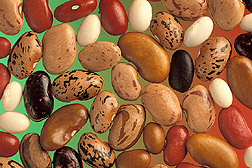The genome of the water mould responsible for Potato blight, and resultantly the great Irish famine, Phytophthora infestans, has been published in this week's Nature and there are some tantalising targets for attack.
 When we talk about the potato famine, which famously hit Ireland between 1845 and 1852, it seems like an historical, rather than contemporary concern. But plant diseases like potato blight remain a threat to food security worldwide - current annual losses due to blight are an estimated $6.7 billion.
When we talk about the potato famine, which famously hit Ireland between 1845 and 1852, it seems like an historical, rather than contemporary concern. But plant diseases like potato blight remain a threat to food security worldwide - current annual losses due to blight are an estimated $6.7 billion.
Preventing and treating blight has proven particularly difficult because it seems to adapt remarkably quickly to control methods, quickly taking hold in cultivars of potato that are, or rather were, genetically resistant to blight. Now, with the publication of its genome, we can start to understand just how it adapts so quickly, and devise better ways to fight it.
Chad Nusbaum, from the Broad Institute of MIT and Harvard, Cambridge, Massachusetts and colleagues from all over the world analysed the genome and compared it to other species of Phytopthora. They found a dense region of highly conserved genes, ones that the different species share, but the majority of the genome consisted of repeating regions.
This repetitive region of the genome was seen to contain genes that alter the normal biological processes in the plant, helping the blight to get past the plants defences. It also contained bits of DNA known to move around the genome, known as transposons, and this ability to alter the genome quite dramatically is thought to be a key feature in the rapid adaptability of the disease. Now that we know how it's doing it - we can start to identify targets for attack.
 In a related paper in Current Biology this week, Dawn Arnold, from the university of the West of England, or UWE, reports on how the defences of the bean plant may be driving bacteria to become more pathogenic.Working with teams from Imperial College London & Reading University, the UWE researchers looked at Pseudamonas syringae, the bacteria that causes halo blight in bean plants. They observed that the bacterium, in response to the bean plant's defences, ejects a region of their DNA, or a Genomic Island, which is then taken up by other bacteria. This allows for horizontal gene transfer, which is thought to play a key role in the evolution of bacteria.
In a related paper in Current Biology this week, Dawn Arnold, from the university of the West of England, or UWE, reports on how the defences of the bean plant may be driving bacteria to become more pathogenic.Working with teams from Imperial College London & Reading University, the UWE researchers looked at Pseudamonas syringae, the bacteria that causes halo blight in bean plants. They observed that the bacterium, in response to the bean plant's defences, ejects a region of their DNA, or a Genomic Island, which is then taken up by other bacteria. This allows for horizontal gene transfer, which is thought to play a key role in the evolution of bacteria.
We know that bacteria can swap sections of their genome, and swapping of the pathogenic genomic island has been seen working in a few different ways in some pretty nasty characters - yersinia, which causes plague; the food poisoning bacteria salmonella and Vibrio cholerae, responsible for cholera. However, this is the first time that it's been seen to happen within a host, and seems to be encouraged by the stress of host immune attack.
Looking at the rest of the genome, they were able to identify genes that were essential to allow this gene transfer to occur. We may now be able to target these genes to help slow the development of pathogenicity and resistance in a range of bacteria, and make our disease control systems much longer lasting.
- Previous Addicted to Memories
- Next Prostate cancer infection link










Comments
Add a comment